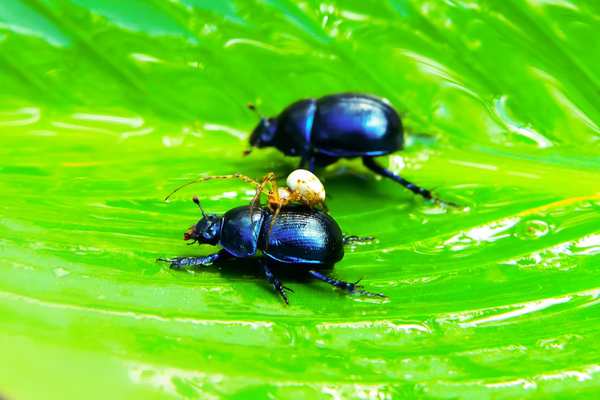
Bugs and insects, are they two of the same thing? Either they annoyingly fly around you or bite a part of your body, they really are creepy crawlies and you can’t tell us otherwise. However, whether you tolerate these little critters or be content with your life without them, you may have asked yourself the question: which is which? Which are the bugs and which are the insects?
At first glance, they mean the same group in the animal kingdom and are used interchangeably with “insects” mostly used in scientific context and “bugs” for more casual conversations. However, they’re more different than you think they are—and let’s just get on with the article so we can get you up to speed!
Here’s everything you need to know about our resident creepy crawlies, the bugs and insects!
Description and Appearance

To continue our conversation, the borders around insects are far clearer compared to that of bugs’. Coming from the class in the phylum Arthropoda, just like arachnids (spiders), myriapods (centipedes), and crustaceans (crawfish), all insects and arthropods have segmented legs and sturdy exoskeletons. Some insects are different, however, having six legs, a pair of antennas, and a clear three-segmented body made up of the head, thorax, and abdomen. As far as you’re concerned, you may have been calling a number of insects as bugs such as ants, flies, bees, and grasshoppers.
As for bugs, all bugs are insects—but not all insects are bugs. This is getting too complicated but bear with us. Hemiptera, a group under the order of insects, is where bugs belong. Physically, there are a couple of characteristics that are distinguishable only to bugs like a straw-shaped mouth, long antennae, and wings. Stink bugs, bed bugs, water striders, and cicadas are true examples of bugs. However, not every name that ends with “bug” is a bug, mind you. The likes of the ladybug and June bugs are actually both beetles—automatically excluding them from the list of bugs.
Some insects, like the mantis, vary in color. And though some of their colored mates are pretty rare sights, Gage Beasley made sure you got to see one in real life—just in plushie form. This Pink Orchid Mantis Soft Stuffed Plush Toy is the cutest and most uniquely-colored mantis plushie you will ever see!

Gage Beasley’s Pink Orchid Mantis Soft Stuffed Plush Toy
But of course, a pink mantis warrants a normal mantis’ appearance. If you ever thought that the mantis in Kung Fu Panda was great, Gage Beasley’s Green Chinese Mantis Soft Stuffed Plush Toy is equally as good. Don’t worry, it doesn’t bite. All it can do is pray for you to sleep. Heh, get it? ‘Cause, it’s a “praying” mantis? No?

Gage Beasley’s Green Chinese Mantis Soft Stuffed Plush Toy
Diet

Bugs and insects have varying diets, but most insects are herbivorous and feed on plants such as stems, leaves, seeds, and flowers. Caterpillars are the strongest example of herbivorous insects—consuming a large volume of leaves as they prepare for their pupal stage and metamorphosis.
There are insects that are frugivores, on the other hand, ones that eat fruit. This list includes beetles, a handful of butterflies and flies, maggots, wasps, hornets, and aphids. These insects are more receptive to either very ripe or decaying fruits—their usual source of nutrients and carbohydrates.
However, there are also carnivorous insects that focus on meat more than plants and fruits. Carnivorous, in this sense, can mean a lot of things for insects. Some insects eat other insects, some feast on decaying animal flesh, and some are most notable for drinking blood. Does that technically make vampires insects? Either way, what we do know is that the likes of the praying mantis and dragonflies are great examples of carnivorous insects.
Dragonflies eat smaller dragonflies, butterflies, moths, mosquitos, and midges. Praying mantises, on the other hand, eat smaller mantises, fish, lizards, and even frogs. The female praying mantis practices sexual cannibalism—eating males that attempt to mate with them.
Reproduction
The adult life of an insect is primarily tailored to its reproduction. In almost all members of the insect family, reproduction is sexual which means mating, impregnation, and fertilization are key factors to their reproductive cycle. Seeking mates vary from insect to insect. For example, male butterflies are more attracted to the color of the female during flight.
For insects, however, the most important element in mating is undoubtedly their odor. Most female insects secrete substances called pheromones and these serve as the main attraction for males. Males, too, are capable of producing scents that can excite their female counterparts. Male butterflies, for example, have scales on their wings that entice the females.
Finding the right mate is one thing, but mating and egg production are certainly another. In attempting these processes, the temperature and the insect’s nutrition must be appropriate and adequate enough. These two factors are the main influencers of hormone secretion.
If there’s a weird wildcard for insect reproduction out there, it has to be the Atlas Beetle. These insects are wicked strong and fight MMA style during mating season for the right to mate. They use their huge horns to push opponents over branches, topple them off trees, or just straight up kill them with it. Gage Beasley’s very own Atlas Beetle Soft Stuffed Plush toy isn’t going to topple you to sleep, but it will knock you to sleep, though, but in a good way.

Gage Beasley’s Atlas Beetle Soft Stuffed Plush Toy
Distribution and Conservation Status

There is an extreme amount of insects all around the world and scientists know this. In fact, attempting to estimate the individual numbers of insects can prove to be an impossible task as these numbers could easily be incomprehensible, to say the least. Their large populations are normally attributed to their very small sizes, rates of reproduction, and very abundant source of nutrients.
If there was ever a rough estimate, the process would be easier if it was taken into account per square yard of rich moist surface soil. In the north temperate zone, it wouldn’t be all that surprising to see around 2,000 insects in the soil sample—amounting to 4 million insects per moist acre (almost half a hectare). In that area, the likes of a butterfly, beetle, bumblebee, and all sorts of common insects should be found. In that number, only a few thousand will attack crops and products, as well as carry diseases, and will need counteracting measures to deal with so as to not interfere with human life.
To say the least, insects are found everywhere—freshwater included. As long as the food is available, they can easily live in deserts, jungles, glacial fields, high mountains, ponds, and even seawater—not to mention some can even live in petroleum.
Conclusion:
Creepy crawlies are, indeed, creepy—but they do play an important role in nature. They assist bacteria and other organisms like fungi in the decomposition of organic matter. Decays are usually accelerated by the likes of flesh flies and blowflies. Moths and beetles are important parts of the cause, too, as they break down the hair and feathers of dead beings. In nature, insects and flowers grow together in the process of pollination—a mutual benefit for both parties.
Insects are also known for their marketable, commercial products such as honey, wax, pigments, and silk, amongst all else. All of these are used to benefit human life. However, let’s not forget that insects are also dangerous beings capable of causing a considerable amount of agricultural damage.
If anything, though, these creepy crawlies are more beneficial than anything. Some of them are beautiful like ladybugs and butterflies, but some of them aren’t as aesthetically pleasing to look at. Either way, as long as they contribute to the environment and to human products, we’ll let their “creepy” side out of the equation.
Cheers!
~GB

Deixe um comentário